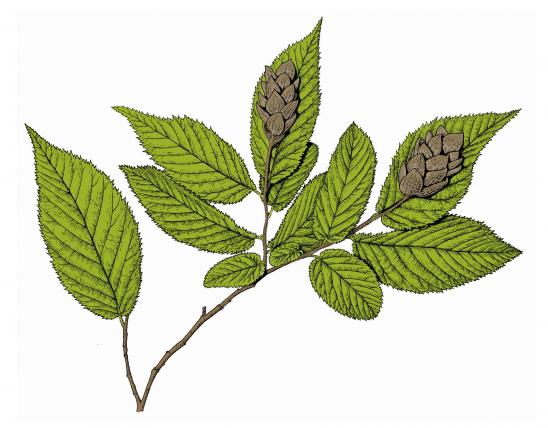
European alder is a medium-sized tree, suckering and forming thickets; fast-growing when young; usually developing a single trunk with an oval-headed crown. In landscaping, it is sometimes grown as a "feature" plant with multiple trunks.
Leaves alternate, simple; dark glossy green; usually nearly circular, 1½–5 inches long; the tip shallowly notched, appearing cut off (truncate), or sometimes broadly rounded; margins coarsely toothed, sometimes also with small lobes.
Flowers March–April, male and female catkins borne on the same tree; female catkins resembling dark conifer cones.
Fruits mature in autumn and persist into winter; resemble miniature oval pinecones ¾–1¼ inches long; seeds are narrowly winged.
Similar species: Our native species of alder is the common alder, Alnus serrulata, which is usually much smaller and has narrower leaves that have finely toothed (not lobed) edges. In addition to the most typical European alder described here, there are other horticultural varieties that people may plant, featuring yellow leaves, cut leaves, columnar growth, and other unusual characteristics.
Height: to about 50 feet.

Planted statewide. Based on evidence worldwide, it certainly has the potential to reproduce on its own, but in Missouri it has only been documented escaping from cultivation in Greene County.
Habitat and Conservation
This tree tolerates waterlogged soil and is sold as an ornamental for wet or boggy sites, especially in the northeastern United States. It can also survive in drier areas. Many landscapers like European alder because, like a legume, it can fix atmospheric nitrogen and improve soil fertility. Also, it tolerates both acid and slightly alkaline conditions. If you are considering planting this species, read more about it — and consider native alternatives, too, including common alder.
Status
Native to Europe and Asia, this tree is planted widely as an ornamental. In some parts of the United States and elsewhere in the world, this species becomes weedy to the point of becoming a big problem. In Missouri, it is known to have escaped from cultivation in only one locality, along the shore of Lake Springfield, in Greene County. Because of this one record, it is officially included in the flora of our state.
Human Connections
European alder boasts a lengthy list of historic uses in the Old World, ranging from various medicinal uses to lumber, furniture, clog-making and the smoking of fish. Today, it is widely used as an ornamental, for land reclamation, and as a starter tree for reforestation.
Ecosystem Connections
We all know about the importance of trees as habitat for birds, but one of the big ecological benefits of this tree lies underground. Alder roots develop nodules that contain symbiotic bacteria that transform inert gaseous nitrogen into nitrates that plants can use for nourishment.



























